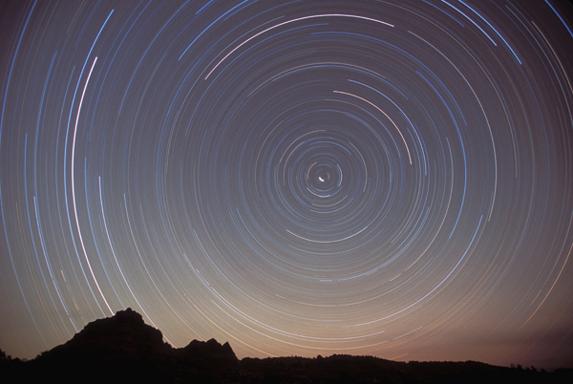CHASING THE SPEED OF LIGHT
Open your eyes and the world floods in; light seems to jump from object to retina, forming a picture of the world instantaneously. Light seems to travel infinitely fast, so it is no surprise that Aristotle and many other philosophers and scientists believed light travelled ‘without movement’. However, as the Greek philosophers gave more thought to the nature of light, a debate about its speed of travel ensued that continued for thousands of years.
In one corner sat eminent names such as Euclid, Kepler and Descartes, who all sided with Aristotle in believing that light travelled infinitely fast. In the other, Empedocles and Galileo, separated by almost two millennia, felt that light must travel at a finite, if extremely high, velocity. Empedocles’s reasoning was elegant, pre-dating Aristotle by a century. He considered light travelling across the vast distance from the Sun to Earth, and noted that everything that travels must move from one point to another. In other words, the light must be somewhere in the space between the Sun and the Earth after it leaves the Sun and before it reaches the Earth. This means it must travel with a finite velocity. Aristotle dismissed this argument by invoking his idea that light is simply a presence, not something that moves between things. Without experimental evidence, it is impossible to decide between these positions simply by thinking about it!
Galileo set out to measure the speed of light using two lamps. He held one and sent an assistant a large distance away with another. When they were in position, Galileo opened a shutter on his lamp, letting the light out. When his assistant saw the flash, he opened his shutter, and Galileo attempted to note down the time delay between the opening of his shutter and his observation of the flash from his assistant’s lamp. His conclusion was that light must travel extremely rapidly, because he was unable to determine its speed. Galileo was, however, able to put a ‘limit’ on the speed of light, noting that it must be at least ten times faster than the speed of sound. He was able to do this because if it had been slower, he should have been able to measure a time delay. So, the inability to measure the speed of light was not deemed a ‘no result’, but in fact revealed that light travels faster than his experiment could quantify.

The question, how fast is the speed of light, has plagued scientists for thousands of years. Part of the answer came from observing how light travels between points: from the Sun to Earth.
The first experimental determination that the speed of light was not infinite was made by the seventeenth-century Danish astronomer, Ole Romer. In 1676, Romer was attempting to solve one of the great scientific and engineering challenges of the age; telling the time at sea. Finding an accurate clock was essential to enable sailors to navigate safely across the oceans, but mechanical clocks based on pendulums or springs were not good at being bounced around on the ocean waves and soon drifted out of sync. In order to pinpoint your position on Earth you need the latitude and longitude. Latitude is easy; in the Northern Hemisphere, the angle of the North Star (Polaris) above the horizon is your latitude. In the Southern Hemisphere, things are more complicated because there is no star directly over the South Pole, but it is still possible with a little astronomical know-how and trigonometry to determine your latitude with sufficient accuracy for safe navigation.
Longitude is far more difficult because you can’t just determine it by looking at the stars; you have to know which time zone you are in. Greenwich in London is defined as zero degrees longitude; as you travel west from Greenwich across the Atlantic, your time zone shifts so that in New York it’s earlier in the day than in London. Conversely, as you travel east from Greenwich your time zone shifts so that in Moscow or Tokyo it’s later in the day than in London.
Your precise time zone at any point on Earth’s surface is defined by the point at which the Sun crosses an imaginary arc across the sky between the north and south points on your horizon, passing through the celestial pole (the point marked by the North Star in the Northern Hemisphere). Astronomers call this arc the Meridian. The point at which the Sun crosses the Meridian is also the point at which it reaches its highest position in the sky on any given day as it journeys from sunrise in the east to sunset in the west. We call this time noon, or midday. Earth rotates once on its axis every twenty-four hours – fifteen degrees every hour. This means two points on Earth’s surface that are separated by fifteen degrees of longitude will measure noon exactly one hour apart. So to determine your longitude, set a clock to read 12 o’clock when the Sun reaches the highest point in the sky at Greenwich. If it reads 2pm when the Sun reaches its highest point in the sky where you are, you are thirty degrees to the west of Greenwich. Easy, except that you need a very accurate clock that keeps time for weeks or months on end 

These spectacular star trails are produced in the sky as a result of diurnal motion. This is the motion created as Earth spins on its axis at fifteen degrees per hour, rotating once over twenty-four hours.
© Scott Smith/Corbis
 ТЕЛЕГРАМ
ТЕЛЕГРАМ Книжный Вестник
Книжный Вестник Поиск книг
Поиск книг Любовные романы
Любовные романы Саморазвитие
Саморазвитие Детективы
Детективы Фантастика
Фантастика Классика
Классика ВКОНТАКТЕ
ВКОНТАКТЕ